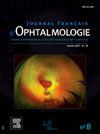T2高信号在眼外肌肥大中的意义
IF 1.1
4区 医学
Q3 OPHTHALMOLOGY
引用次数: 0
摘要
眼外肌(EOM)的炎症,或肌炎,导致肌肉增大和增厚。这种疾病是由于甲状腺相关眼病(TAO)或全身性疾病引起的眼窝炎症综合征。本研究的目的是评估T2高信号在EOM肌炎病例中的意义。材料和方法在这项回顾性研究中,我们将数据收集的重点放在EOMs中是否存在MRI-T2高强度以及眼科医生记录中描述的标准上,如眼痛、运动受限、眼球突出和红肿。MRI检查在3.0 T系统上进行,带有16通道头部线圈,扫描前注射钆。常规结构成像包括轴向T1加权成像、轴向t2加权成像、轴向、冠状和斜矢状t2加权成像及脂肪抑制序列。结果本组共纳入26例患者(42个眼眶)。18例患者(31个眼眶)至少有一块肌肉出现T2高强度。31个T2高信号眼眶中有30个表现为EOM肥大(P≤0.0001)。肥大的eom平均数目为2.67±2.47个。10例患者在治疗前后分别行MRI检查。有趣的是,在所有接受过口服皮质类固醇治疗肌炎的患者中,有50%的患者在MRI扫描中仍然存在T2高强度。结论t2高强度与肌肉增大密切相关。皮质类固醇治疗后T2高信号的持续存在需要另一项研究来更好地了解该参数的临床意义。前言:眼外肌炎、肌外肌炎、肌肥大、肌内变性。观察超常异常眼窝炎综合征dû本文章由计算机程序翻译,如有差异,请以英文原文为准。
Significance of T2 hyperintensity in extraocular muscle hypertrophy
Introduction
Inflammation of the extraocular muscles (EOM), or myositis, results in an enlargement and thickening of the muscle. This disorder is encountered in orbital inflammation syndrome due to thyroid-associated orbitopathy (TAO) or systemic disease. The goal of this study was to evaluate the significance of T2 hyperintensity on MRI in the case of EOM myositis.
Material and methods
In this retrospective study, we focused our data collection on the presence or absence of MRI-T2 hyperintensity in the EOMs and criteria described in the ophthalmologist's record, such as ocular pain, motility restriction, proptosis and redness. MRI examinations were performed on a 3.0 T system with a 16-channel head coil, with Gadolinium injection prior to the scan. Conventional structural imaging included axial T1 weighted imaging, axial T2-weighted imaging, and axial, coronal, and oblique sagittal T2-weighted imaging with fat-suppression sequences.
Results
In total, 26 patients (42 orbits) were included in this study. Eighteen patients (31 orbits) showed T2 hyperintensity in at least one muscle. Thirty of 31 orbits with T2 hyperintensity showed EOM hypertrophy (P ≤ 0.0001). The mean number of hypertrophied EOMs was 2.67 ± 2.47. Ten patients underwent MRI prior to and after the conclusion of treatment. Interestingly, 50% of all patients with a history of oral corticosteroid treatment for myositis still had T2 hyperintensity on their MRI scans.
Conclusion
T2 hyperintensity is strongly correlated with enlargement of the muscle. The persistence of a T2 hypersignal after corticosteroid treatment requires another study to better understand the clinical significance of this parameter.
Introduction
L’inflammation d'un muscle extra-oculaire ou myosite se traduit par une hypertrophie/épaississement du muscle. On observe surtout cette anomalie dans le syndrome d’inflammation orbitaire dû à une orbitopathie dysthyroïdienne ou dans le syndrome inflammatoire orbitaire idiopathique (SIOI). Le but de l’étude était d’évaluer l’intérêt de l’hypersignal T2 en IRM dans le cas d’une myosite de l’orbite.
Matériel et méthodes
Dans cette étude rétrospective, nous avons focalisé nos données sur la présence d’un hypersignal T2 en IRM des muscles oculo-moteurs associés à la douleur oculaire, la restriction de la motilité, l’exophtalmie et la rougeur. Les examens IRM ont été réalisés sur un système 3.0 T avec une bobine de tête à 16 canaux avec injection de Gadolinium. L’imagerie structurelle conventionnelle comprenait une imagerie axiale pondérée en T1, une imagerie axiale pondérée en T2 et une imagerie sagittale axiale, coronale et oblique pondérée en T2 avec des séquences de suppression de la graisse.
Résultats
Au total, 26 patients dont 42 orbites ont été retenus pour cette étude. Dix-huit patients (31 orbites) présentaient des signaux d’hypersignal T2 dans au moins un muscle. Trente des 31 orbites présentaient un hypersignal T2 avec une hypertrophie du muscle (p ≤ 0,0001). La mesure de l’hypertrophie musculaire était de 2,67 ± 2,47. Dix patients ont bénéficié d’une IRM avant et après la fin du traitement.
Conclusion
L’hypersignal T2 dans les myosites des muscles oculo-moteurs est corrélé à l’augmentation de la taille du muscle. La persistance d’un hypersignal T2 après traitement corticoïde nécessite une autre étude pour mieux comprendre l’intérêt clinique.
求助全文
通过发布文献求助,成功后即可免费获取论文全文。
去求助
来源期刊
CiteScore
1.10
自引率
8.30%
发文量
317
审稿时长
49 days
期刊介绍:
The Journal français d''ophtalmologie, official publication of the French Society of Ophthalmology, serves the French Speaking Community by publishing excellent research articles, communications of the French Society of Ophthalmology, in-depth reviews, position papers, letters received by the editor and a rich image bank in each issue. The scientific quality is guaranteed through unbiased peer-review, and the journal is member of the Committee of Publication Ethics (COPE). The editors strongly discourage editorial misconduct and in particular if duplicative text from published sources is identified without proper citation, the submission will not be considered for peer review and returned to the authors or immediately rejected.

 求助内容:
求助内容: 应助结果提醒方式:
应助结果提醒方式:


